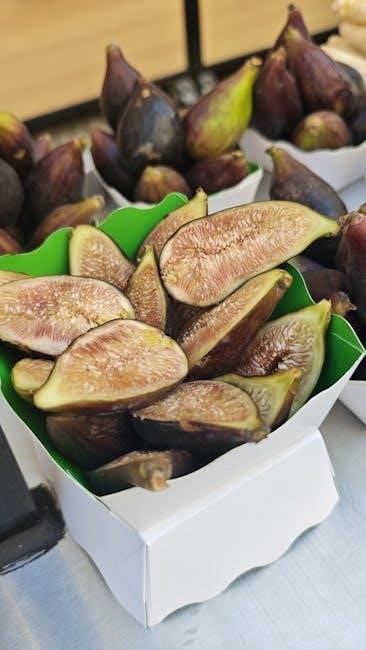Sweet potatoes are versatile, nutrient-rich root vegetables, widely enjoyed globally․ They offer a delicious and healthy base for various dishes, from traditional casseroles to modern twists, enhancing flavors naturally․
1․1 What Are Sweet Potatoes?
Sweet potatoes are starchy, sweet-tasting root vegetables, often orange in color but also found in yellow, white, and purple varieties․ Native to the Americas, they are a staple in many cuisines worldwide․ Unlike regular potatoes, sweet potatoes are sweeter due to their higher sugar content, particularly when cooked․ They are versatile in preparation, served mashed, baked, roasted, or used in dishes like casseroles and soups․ Sweet potatoes are also valued for their nutritional benefits, making them a popular choice in both traditional and modern recipes․ Their adaptability and rich flavor have made them a cornerstone in global cuisine, enjoyed across cultures and culinary traditions․ Whether in savory dishes or sweet desserts, sweet potatoes offer a delicious and nutritious option for any meal․
1․2 Importance in Global Cuisine
Sweet potatoes hold a significant place in global cuisine, featured in diverse dishes across continents․ In the United States, they are a staple during Thanksgiving, often served as casseroles․ In African countries like South Africa and Namibia, they are boiled or roasted as a side dish․ Latin American cuisines use them in both sweet and savory recipes, while in Asia, they appear in soups, stir-fries, and desserts․ Their adaptability and nutritional value make them a key ingredient in many traditional and modern meals․ Whether baked, mashed, or incorporated into innovative dishes, sweet potatoes enhance flavors and provide sustenance, making them a cherished component of global culinary traditions and a testament to their enduring popularity worldwide․ Their versatility ensures they remain a fundamental element in kitchens across the globe․

History and Origin
Sweet potatoes have been cultivated for over 7,000 years, originating in the Americas․ They were a staple food for indigenous peoples and later spread globally through trade and colonization, becoming a vital crop in many cultures․
2․1 Ancient Roots
The sweet potato’s journey began in ancient South America, where it was first domesticated around 7,000 years ago․ Archaeological evidence shows it was a primary food source for pre-Columbian civilizations, including the Incas․ Early varieties were cultivated for their starchy, sweet flesh, providing sustenance and energy․ Indigenous peoples revered the sweet potato not only for its nutritional value but also for its adaptability to diverse climates․ Its prominence in ancient diets highlights its role as a foundational crop, enabling the growth of settled communities and agricultural practices that would shape future societies․
2․2 Global Spread
The sweet potato’s global journey began in the 16th century when Spanish and Portuguese traders introduced it to Europe, Africa, and Asia․ By the 18th century, it had become a staple in many regions, particularly in the Caribbean and Southern United States․ African enslaved laborers played a crucial role in cultivating sweet potatoes in these areas, adapting them to new soils and climates․ In Asia, the sweet potato became a vital crop in China, the Philippines, and Japan, where it was integrated into traditional dishes and farming practices․ Its adaptability and nutritional value made it a key crop during times of scarcity, ensuring its widespread adoption across continents․
Today, sweet potatoes are grown in over 100 countries, with major producers including China, Uganda, and the United States․ This global spread underscores its resilience and cultural significance, making it a cornerstone of food systems worldwide․

Nutritional Profile

Sweet potatoes are rich in vitamins A and C, potassium, and dietary fiber, offering excellent antioxidant properties․ They provide essential minerals like iron and zinc, supporting overall well-being․
3․1 Vitamins and Minerals
Sweet potatoes are a powerhouse of essential vitamins and minerals, making them a highly nutritious addition to any diet․ They are particularly rich in vitamin A, derived from beta-carotene, which supports healthy vision, immune function, and skin health․ Additionally, they contain significant amounts of vitamin C, which aids in immune system support and collagen production․ Minerals like potassium, iron, and zinc are also present, contributing to heart health, blood function, and immune defense․ The high fiber content promotes digestive well-being, while the natural antioxidants enhance overall nutritional value․ This nutrient-dense profile makes sweet potatoes a versatile and beneficial choice for maintaining a healthy lifestyle․
3․2 Antioxidants and Fiber
Sweet potatoes are abundant in antioxidants, particularly beta-carotene, which converts to vitamin A in the body, protecting cells from oxidative damage and reducing inflammation․ They also contain other carotenoids like lutein and zeaxanthin, which support eye health․ The high fiber content in sweet potatoes aids in digestion, promoting a healthy gut microbiome and preventing constipation․ This fiber also helps regulate blood sugar levels, making sweet potatoes a beneficial choice for managing diabetes․ Additionally, antioxidants like anthocyanins, found in purple sweet potatoes, have been linked to improved cognitive function and reduced risk of chronic diseases․ The combination of antioxidants and fiber makes sweet potatoes a nutrient-dense food that supports overall well-being and longevity․

Culinary Versatility
Sweet potatoes are incredibly versatile, suited for baking, mashing, roasting, or frying, and feature in both traditional and modern recipes worldwide, enhancing various cuisines with their rich flavor․
4․1 Traditional Recipes
Traditional sweet potato recipes highlight their natural sweetness and versatility, often passed down through generations․ A classic dish is the sweet potato casserole, a staple in many cultures, featuring mashed sweet potatoes topped with marshmallows, nuts, or streusel․ Another beloved recipe is twice-baked sweet potatoes, where the flesh is seasoned and stuffed back into the skin for a flavorful, hearty side dish․ In some regions, sweet potatoes are boiled or roasted whole, served alongside grains or meats․ They’re also used in soups, stews, and traditional breads, offering a nutritious and delicious base․ These dishes showcase the simplicity and richness of sweet potatoes in global cuisine, making them a cherished ingredient in countless traditional meals․
4․2 Modern Twists
Modern recipes have reimagined sweet potatoes in exciting ways, blending tradition with innovation․ Sweet potato gnocchi, a trendy dish, combines mashed sweet potatoes with flour for a light, pillowy texture․ They’re also used as a base for vegan dishes, like sweet potato chick’n salads or stuffed sweet potato boats with global flavors․ Another modern twist is sweet potato toast, where slices are roasted and topped with avocado, eggs, or hummus for a nutritious breakfast․ Additionally, sweet potato powders are incorporated into smoothies and baked goods for added nutrition; These creative adaptations showcase the root’s versatility, making it a favorite in contemporary cuisine while maintaining its natural health benefits․ Social media and food blogs have further popularized these modern takes, inspiring home cooks to experiment and innovate with sweet potatoes in new ways․

Health Benefits
Sweet potatoes are rich in vitamins A and C, potassium, and fiber, supporting immune function, digestion, and overall well-being․ Their antioxidants combat inflammation and promote healthy aging․
5․1 Digestive Health
Sweet potatoes are a rich source of dietary fiber, which plays a key role in maintaining healthy digestion․ The high fiber content helps regulate bowel movements, preventing constipation and promoting regularity․ Additionally, sweet potatoes contain antioxidants that protect the digestive tract from oxidative stress and inflammation․ Vitamin A in sweet potatoes supports the health of the gut lining, reducing the risk of infections and digestive disorders․ The natural sweetness and soft texture make them easy to digest, making them an excellent choice for those with sensitive stomachs․ Regular consumption of sweet potatoes can also support the growth of beneficial gut bacteria, enhancing overall gut health and immune function․ Their anti-inflammatory properties further aid in soothing digestive issues, making them a nutritious and beneficial addition to a healthy diet․
5․2 Immune System Support
Sweet potatoes are a powerful ally for immune system support due to their rich vitamin and mineral content․ High levels of vitamin A, obtained from beta-carotene, help protect cells from damage and promote the production of white blood cells, essential for fighting infections․ The antioxidants present in sweet potatoes, such as polyphenols, reduce oxidative stress and inflammation, which can weaken the immune system․ Additionally, they contain vitamin C, which supports immune cell function and enhances the body’s ability to combat pathogens․ Regular consumption of sweet potatoes also provides essential minerals like zinc and iron, which are critical for a healthy immune response․ By incorporating sweet potatoes into your diet, you can strengthen your immune system and reduce the risk of illnesses, making them a nutritious and beneficial choice for overall health․

Growing Sweet Potatoes
Sweet potatoes thrive in warm climates with well-drained soil․ They require full sunlight and consistent moisture for optimal growth, making them a rewarding crop to cultivate․
6․1 Ideal Conditions
Sweet potatoes thrive in warm, sunny environments with average temperatures between 65°F and 95°F․ They prefer well-drained, loose soil with a pH of 5․5 to 6․5․ Full sun is essential for maximum yield․ Consistent moisture, especially during tuber formation, is crucial, though they are drought-tolerant once established․ Ideal conditions also include a long growing season, typically 100 to 150 days, allowing tubers to mature fully․ Planting in raised beds or mounds improves drainage and soil warmth, enhancing growth․ Avoiding waterlogged soil prevents root rot, a common issue․ Overall, sweet potatoes adapt well to various climates but excel in regions with warm, dry seasons, making them a versatile crop for many growers․
6․2 Common Challenges
Growing sweet potatoes can present several challenges․ Root rot is a prevalent issue, often caused by overwatering or poorly drained soil․ To prevent this, ensure the soil is well-drained and avoid excessive moisture․ Pests like wireworms and nematodes can also damage the crop, requiring careful monitoring and organic control methods․ Additionally, sweet potatoes are sensitive to temperature fluctuations; prolonged exposure to cooler temperatures can stunt growth․ Ensuring optimal soil warmth, especially in cooler climates, is crucial․ Another challenge is soil quality—sweet potatoes prefer loose, fertile soil, and heavy clay or sandy soils can hinder tuber development․ Regular soil preparation and amendments, such as adding compost or well-rotted manure, can help mitigate these issues․ Addressing these challenges effectively ensures a healthy and productive sweet potato harvest․

Cultural and Historical Significance
Sweet potatoes hold deep cultural and historical value, featuring prominently in traditional dishes and rituals worldwide․ They symbolize abundance, resilience, and community, reflecting their enduring importance across generations․
7․1 Role in Different Cultures
Sweet potatoes are deeply embedded in the cultural fabric of various societies․ In many African countries, they serve as a staple food, featuring in traditional dishes and ceremonies․ Similarly, in the Caribbean, they are a key ingredient in festive meals․ In Asia, sweet potatoes are used in both savory and sweet preparations, reflecting their adaptability․ Indigenous communities worldwide often revere them for their nutritional and symbolic significance․ Moreover, in Western cuisines, sweet potatoes have become a popular choice for innovative recipes, blending tradition with modernity․ Their versatility and cultural significance make them a beloved ingredient across diverse regions and traditions, highlighting their enduring importance globally․ Sweet potatoes truly connect people through shared culinary practices and cultural heritage, transcending borders and time․
7․2 Historical Use
Sweet potatoes have been a cornerstone of human nutrition for thousands of years, with evidence of their cultivation dating back to ancient times in the Americas․ They were a staple crop for many indigenous peoples, providing sustenance and serving in cultural rituals․ Early European explorers encountered sweet potatoes in the Caribbean, leading to their introduction to Africa, Asia, and Europe․ In Africa, they became a vital crop during colonial times, helping communities survive food shortages․ Similarly, in the Southern United States, sweet potatoes were a key resource during the Civil War and beyond․ Their historical significance is also marked by their role in sustaining populations during times of conflict, such as World War II․ This enduring adaptability has cemented their place in global history as a resilient and life-sustaining food source․ Their historical use reflects their importance as a reliable and nutritious staple across centuries and continents․

Environmental Impact
Sweet potatoes require moderate water and care, making them a sustainable crop․ Their resilience to drought and low carbon footprint contribute to eco-friendly farming practices globally, supporting food security․
8․1 Water Usage
Sweet potatoes require moderate water for optimal growth, typically needing around 500 mm of rainfall or irrigation per growing season․ They are relatively drought-tolerant compared to other crops, making them suitable for regions with water scarcity․ However, consistent moisture levels are crucial during the initial growth stages to ensure healthy root development․ Farmers often use drip irrigation and mulching to minimize water waste and retain soil moisture․ These practices not only conserve water but also enhance soil health, making sweet potato cultivation more sustainable․ By balancing water usage with efficient farming techniques, sweet potatoes can thrive in various environmental conditions while maintaining their nutritional value and flavor․
8․2 Carbon Footprint

Sweet potatoes generally have a relatively low carbon footprint compared to other staple crops․ Their cultivation typically requires less energy-intensive farming practices, as they are resilient and don’t demand heavy pesticides or irrigation systems․ However, factors like transportation, storage, and cooking methods can influence their overall environmental impact․ Locally grown sweet potatoes tend to have a smaller carbon footprint due to reduced transport emissions․ Additionally, their nutrient density means they provide significant health benefits per unit of carbon emitted․ Sustainable farming practices, such as crop rotation and organic methods, further minimize their ecological impact․ Overall, sweet potatoes are a more eco-friendly choice for both nutrition and the environment when produced and consumed responsibly․
